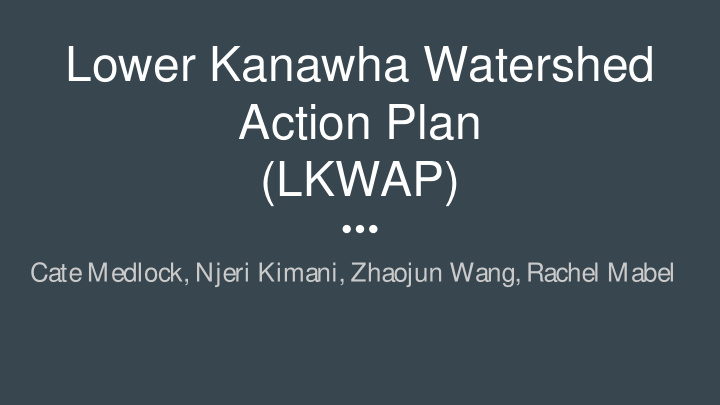



Lower Kanawha Watershed Action Plan (LKWAP) Cate Medlock, Njeri Kimani, Zhaojun Wang, Rachel Mabel
Watershed Background Information Source: WVDEP, 2013.
Population Housing Owner Median Percent of (2010) Units Occupied Household Persons in (2010) Housing Income Poverty Unit Rate (2011-2015) (2011-2015) (2011-2015) South 13,450 6,819 69.9% $46,390 14.1% Charleston Teays Valley 13,175 5,438 82.5% $70,419 6.8% St. Albans 11,044 5,436 69.4% $44,758 13.3% Cross Lanes 9,995 4,580 70.9% $55,773 11.8% West Virginia 1,853,000 881,917 72.5% $41,751 17.9% Source: USCB, 2010.
TMDL A TMDL was developed for 2006 and 201 2. The TMDL targeted 22 subwatersheds that contained 1 22 impaired streams Major impairments Metals Fecal Coliform Biological Impairment Wasteload Allocations (WLAs) and Load Allocations (LAs) included Point Sources: active mining operations, construction stormwater, municipal storm sewer systems, and sewer treatment plants
Major Policies & Developments Clean Water Act (1 972) Safe Drinking Water Act (1 974) Toxic Substance Control Act (1 976) Surface Mining Control & Reclamation Act (1 977) WV Water Resources Protection & Management Act (2004 & 2008)
Environmental Concerns & Proposed Solutions Fecal Bacteria in Streams Industrial Pollution Heavy Metals Traced in Wildlife
Fecal Bacteria in Streams Questions Higher than State contact standard of 200 col/100 ml (West Virginia Department of Natural Resources), and Higher than 400 colonies/100ml established by the Environmental Quality Board. Causes Individual sources covered under the NPDES program such as wastewater treatment plants, combined sewer overflows (CSOs), municipal separate storm sewers (MS4s), and general sewage permits Unpermitted sources: on-site treatment systems, storm water runoff and agriculture. Influence Human health: ear infection, dysentery, typhoid fever Environment: reducing dissolved oxygen levels due to aerobic decomposition of this material
Fecal Bacteria in Streams Goals Reduce and prevent influx into streams By 2040, meet the numeric standards of WV Department of Natural Resources and NPDES permits, which is 200 col/100 ml, helping achieve the Watershed Action goal of swimmable and fishable in 2040
Fecal Bacteria in Streams Solutions Best management practices (BMP) required by CWA ● Actions Pollution Action Urbanization and storm water runoff Reduce impervious cover, build bio-retention covers, build drainage swales. Wild and domestic animals Build fences Household sewage Education to individuals and families ● Technology ○ Two publicly owned treatment works (POTW) ○ 231 general sewage treatment plants. ○ New disposal systems ● Monitor ● Review and revise
Industrial Pollution Three primary forms of industrial pollution Chemical Spills Frequent chemical spills along Kanawha River 2014 Elk River MCHM spill 300,000 people without water Waste from Abandoned Mines Acid mine drainage Large quantities of iron and aluminium Oil and Gas Wells
Industrial Pollution Goa l s Reduce frequency of chemical spills to every 5-10 years Improve monitoring of industrial facilities to limit incidence of major point-source pollution events Ensure chemical safety protocols and standards are being met and enforced Reduce 50% of metal toxicity by 2040
Industrial Pollution Solutions Neutralize acidity from AMD with constructed wetlands and/or lime as part of a BMP Increase the AML&R tax on coal Encourage industrial companies to update equipment and facilities Educate industrial workers on proper safety techniques and the risks of exposure to hazardous chemicals
Heavy Metals Traced in Wildlife Problem Non-point source pollution Logging, energy extraction, construction/ urbanization and agriculture Trace elements found in common carp and rock bass tissue samples Iron and Manganese Concentrations exceeded EPA Secondary Maximum Contaminant Levels (SMCL) Wildlife dependent on aquatic life Reptiles A hibi
Heavy Metals Traced in Wildlife Goal Maintain “fishable” status for the Lower Kanawha River Watershed streams Manage non-point source water runoff and pollution by the year 2040 Protect wildlife dependent on watershed
Heavy Metals Traced in Wildlife Solutions Conduct tests Habitat monitoring Capture and blood sampling of migrant songbirds Louisiana Waterthrush ( Parkesia motacilla ) Volunteers and Interns Green Heron Cost effective https://www.google.com/url?sa=i&rct=j&q=&esrc=s&source=images&cd=&cad=rja&uact =8&ved=0ahUKEwiW- sPd2o3TAhWFTCYKHQrZCHsQjRwIBw&url=http%3A%2F%2Fwww.chesapeakebay.ne t%2Ffieldguide%2Fcritter%2Fgreen_heron&psig=AFQjCNHGDDmsNqysXaqVhG9zT3e nMJbtTw&ust=1491495185177337 Evaluate potential wetland and terrestrial habitat for larger birds:
Heavy Metals Traced in Wildlife Solutions Repair degraded streams and waterways Edges - Plant native grasses https://www.google.com/url?sa=i&rct=j&q=&esrc=s&source=ima ges&cd=&cad=rja&uact=8&ved=0ahUKEwit8o2H0I3TAhWLLS YKHWMWAfkQjRwIBw&url=http%3A%2F%2Fwhatsupstream.c om%2F&psig=AFQjCNGJ- Maintain and create riparian buffer in protected 3GSwi5Ru4mwjlSOmOvVpmzYjg&ust=1491492318240895 areas Canopy and understory trees Marbled Salamander (Ambystoma opacum ) Goal: 2027 https://www.google.com/url?sa=i&rct=j&q=&esrc=s&source=imag es&cd=&cad=rja&uact=8&ved=0ahUKEwjk9cST443TAhWBbSY KHQnmB7oQjRwIBw&url=http%3A%2F%2Fwildsouth.org%2Fm arbled-salamander-ambystoma- opacum%2F&psig=AFQjCNHXUQsMeV7qtW_5ZQa0nX- Establish new protected areas with riparian 5BTjEQQ&ust=1491497454805207 b ff
Heavy Metals Traced in Wildlife Solution Implement Low Impact Development (LID) methods Bioretention Soil- and plant-based filtration devices Absorbs excess stormwater runoff Install in Kanawha valley https://www.nrcs.usda.gov/wps/portal/nrcs/detail/ia/newsroom/factsheets/? cid=nrcs1 42p2_00851 8 90% reduction of copper, zinc and lead in water Permeable pavements D d t fl di
Stakeholder Summary US Environmental Protection Agency - Federal US Geological Survey - Federal WV Division of Natural Resources - State WV Office of Land & Streams - State WV Department of Environmental Protection - State WV Conservation Agency (Nonprofit) Coal River Group (Nonprofit)
Questions?
Recommend
More recommend